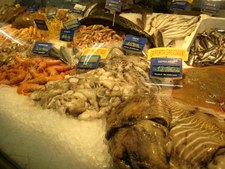
1
Our day began with a visit to GS, an Italian supermarket, one block from our hotel. As always, when I visit Europe, I note how similar the shelves look - until you look closely, and see how different the brands are! Some of the things I saw in GS were brands we see in the US: Barilla, De Cecco. Others were (to me) downright weird: for example, Uncle Ben's Tortilla Chips. (Yes, same face, logo, and package color.)
One thing I noticed, as well: as with stores in Paris, there's relatively little junk food, like chips, taking up aisle after aisle.
This is a shot of the seafood counter. It's mostly octopus, squid and shrimp . . . also, sardines. Yum!
| 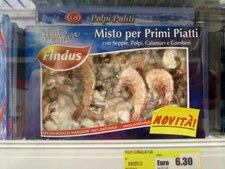
2
Now, why can't I find THIS kind of frozen food in Safeway or Harris Teeter?
| 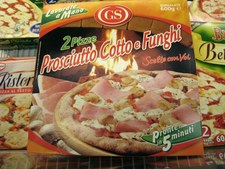
3
Or pizza like this???
|
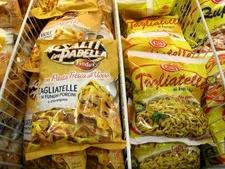
4
I'd also love to see frozen pasta like this.
| 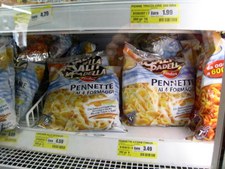
5
And this . . .
| 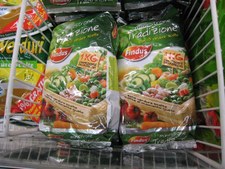
6
And what about these frozen veggies? I get so tired of the same ol' same ol' in US supermarkets.
|
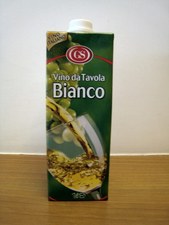
7
Here, we have the Italian version of "Two Buck Chuck." This was one euro. Really. $1.50.
How was it? Well, kinda bad. (Jeff just had to buy it to see what it was like.)
| 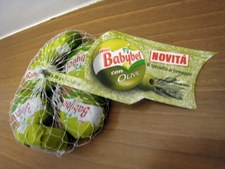
8
We had a fridge in our room, so I bought a few snacks. This is a variety of BabyBel not available in the US. (Nor is it "La Vache qui Rit" or "Laughing Cow;" it's just plain ol' BabyBel) Mild cheese rounds with bits of green olive. It is yummy! And about 65 calories or so, per piece.
By the way, Europe makes you work for your nutritional info; you are given the data for 100 grams, and then you have to do the math.
| 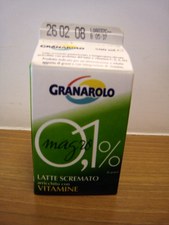
9
I also bought some skim milk, or "latte scremato." (Hopefully this doesn't mean you'll run from it, screaming.)
It was OK; European milk tastes different from US milk (and Japanese milk is even stranger). I assume that has something to do with different processing techniques, or perhaps what the cows are fed.
|
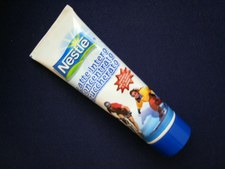
10
I bought this to take with on a long bike ride. It's a tube of energy gel with a bit of protein in it. Appears to be a good recovery product. We shall see. Hope it doesn't taste nasty.
| 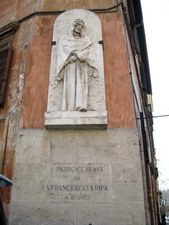
11
I'm trying to remember where this was; it was on a church in one of the many piazzas we passed through in the Trastevere neighborhood.
| 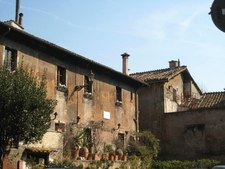
12
I took this pic because it looked so homey and country . . . like it was out in the remote reaches of the countryside. But no, it was smack in the city.
|
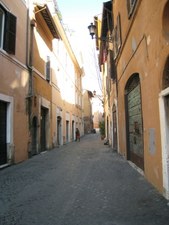
13
One of those narrow streets where you literally can find anything -- from a jewelry store to an art gallery to a nightclub.
| 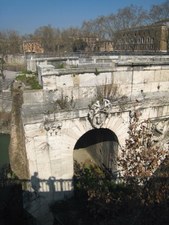
14
The Ponte Rotto, or "broken bridge," right next to the Ponte Palatino. It was built in 179 BC, and only this remains of it.
| 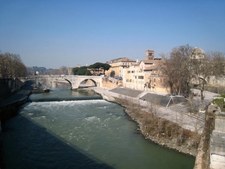
15
Looking past the Ponte Rotto, to the hospital'd island in the middle of the Tiber.
|
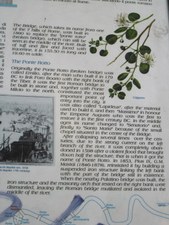
16
About the Ponte Rotto.
| 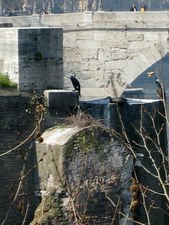
17
Another view of the Ponte Rotto, complete with decorative bird (bet he didn't know he was a design element in my photo composition).
| 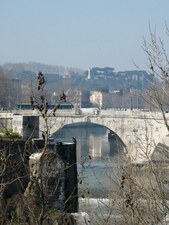
18
Looking back at the Ponte Palatino, from past the Ponte Rotto. (Well-named, isn't it?)
|
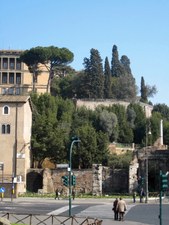
19
A view of the beginnings of the Palatine Hill. See Day 5 for our visit to that site.
If you look to the lower right, you'll see some ruins, just built into the existing landscape. To the Romans, the ruins are a backdrop of sorts.
| 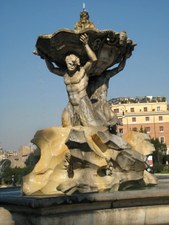
20
Fountain across the street from the legendary church of Santa Maria in Cosmedin. It's a basilica church -- I had to look up what that means. From Wikipedia:
"The Latin word basilica (derived from Greek, Basiliké Stoà, Royal Stoa), was originally used to describe a Roman public building (as in Greece, mainly a tribunal), usually located at the center of a Roman town (forum). In Hellenistic cities, public basilicas appeared in the 2nd century BC."
"After the Roman Empire became officially Christian, the term came by extension to refer to a large and important church that has been given special ceremonial rites by the Pope. Thus the word retains two senses today, one architectural and the other ecclesiastical."
| 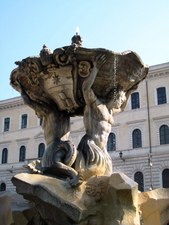
21
Another shot of the fountain.
|
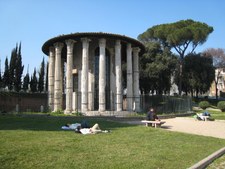
22
No, this isn't the church. I didn't actually take any pics of it, even though it's the famous one with the marble disk, "La Bocca della Verità," in the portico. That disk has been featured in numerous movies.
We didn't go in to see the disk, because the line to get in was around the block.
This is much more interesting, I think . . . it's the Temple of Vesta, across the street from the church.
| 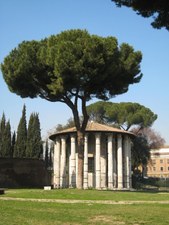
23
Another view of the temple.
| 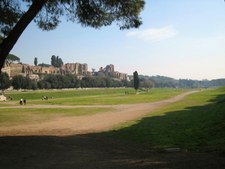
24
The Circus Maximus. Now just an open park with a few markers and other appurtenances here and there, this was once the site of the massive entertainment hippodrome that featured chariot races and other events. It sits between the Aventine and Palatine hills.
More from Wikipedia:
http://en.wikipedia.org/wiki/Circus_Maximus
|
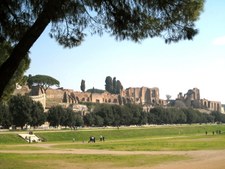
25
Approaching the Circus. The park is very popular with dog walkers and runners.
In the background are the villa ruins atop Palatine Hill. (See Day 5.)
| 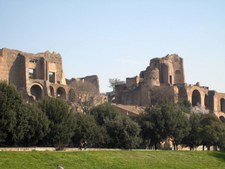
26
Walking in the park. A closer shot of the ruins.
| 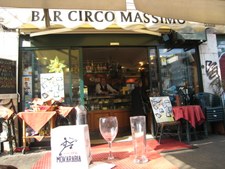
27
After we walked out of the other end of the park, we had lunch (what the cafe referred to as pizza but what I considered more of a foccacia sandwich) at the Bar Circo Massimo (Italian for Circus Maximus). View from our outdoor table. The afternoon was warm, and we were quite content to bask in the sun.
|
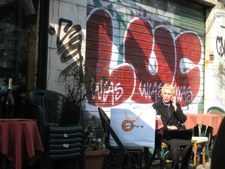
28
Italian women of a certain age tend to dress the same: long skirts and sensible shoes. If memory serves me correctly, not too-too long ago, it was nearly unheard of for Italian women to wear pants . . . and if they did, they invited butt-pinching (or worse, maybe).
Note the ever-present graffiti.
Young Italian women, of course, dress like young American women, only way more stylishly.
| 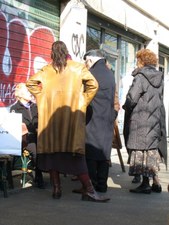
29
More Italian "women of a certain age."
| 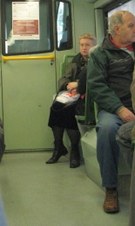
30
Occasionally, I saw fashionable boots, rather than clunky grandma shoes. (Note the boots in the previous photo. Italians are mad for boots, of course, and anything leather.)
|
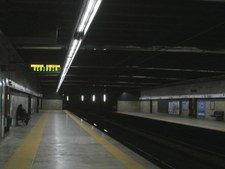
31
View from a subway platform.
| 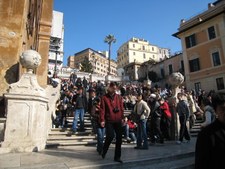
32
The Spanish Steps. Even in February, they are crowded. Well, OK, it was a beautiful day. Maybe that had something to do with it.
Because the steps were so crowded, we didn't climb them. Next trip, perhaps.
| 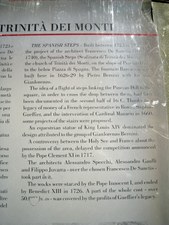
33
English half of the plaque next to the Steps.
|
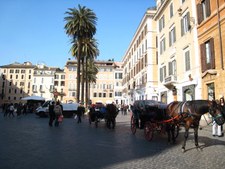
34
Typical piazza. We saw the horse carts in the touristy areas, but nowhere else.
What surprised me most about Rome: palm trees. I didn't realize it was that far south, with the mild climate palmettos require. (That's what these look like; it's a bit like being in Charleston, SC, climate-wise.)
| 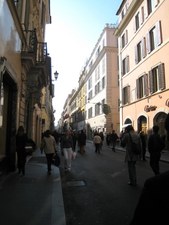
35
A very posh shopping Via. Cartier, Versace, etc.
As I wasn't into dropping that sort of change, we soon wandered off into the side streets (which I found more interesting, anyway.)
| 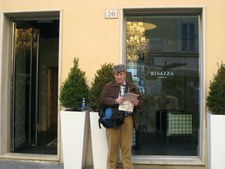
36
A shot of Jeff in front of a Bisazza store. Why? Because I love Bisazza tile; we put it in our renovated rowhouse in Baltimore. Didn't expect to just stumble onto a Bisazza store.
|

37
The obelisk in Piazza Colonna. Almost Egyptian in appearance, it's heavily carved, in a spiral pattern, for its entire length.
| 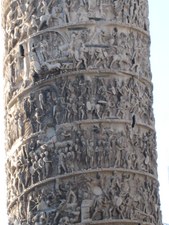
38
Detail view of the obelisk.
| 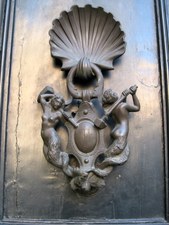
39
I just thought this random doorknocker was cool.
|
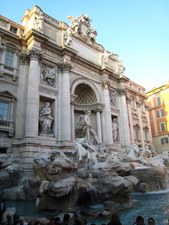
40
The famous Trevi Fountain . . . of "Three Coins in the Fountain" fame, and all that. From Wikipedia:
The fountain at the juncture of three roads (tre vie) marks the terminal point of the "modern" Acqua Vergine, the revivified Aqua Virgo, one of the ancient aqueducts that supplied water to ancient Rome. In 19 BC, supposedly with the help of a virgin, Roman technicians located a source of pure water some 13 km (8 miles) from the city. (This scene is presented on the present fountain's facade). However, the eventual indirect route of the aqueduct made its length some 22 km (14 miles). This Aqua Virgo led the water into the Baths of Agrippa. It served Rome for more than four hundred years. The "coup de grace" for the urban life of late classical Rome came when the Goth besiegers in 537/38 broke the aqueducts. Medieval Romans were reduced to drawing water from polluted wells and the Tiber River, which was also used as a sewer."
"The Roman custom of building a handsome foun...
| 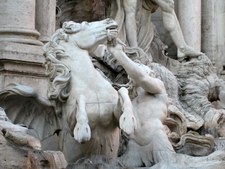
41
Detail from the fountain. I love equine statues, can you tell? Actually, this is a hippocamp, a seahorse, being tamed by a triton.
| 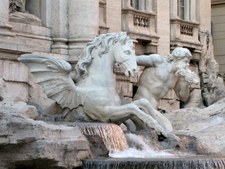
42
Here's the other one (gotta have symmetry).
|
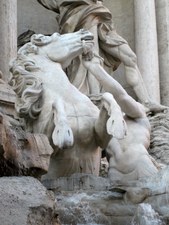
43
Another view of the first one.
| 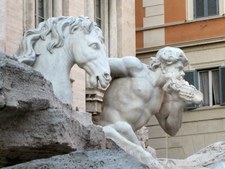
44
And the second Triton -- blowing a shell horn.
| 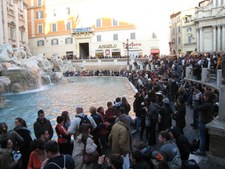
45
Think we were standing there all by ourselves, admiring the fountain? Hah.
I can't imagine what the crowds are like in the real tourist season.
|
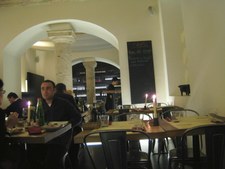
46
We had dinner at a mozzarella bar - yes, this restaurant specializes in very, very fresh varietal mozzarella di bufala (mozzarella made from buffalo milk) from various regions of Italy. Obika Mozzarella Bar also has locations in London and New York City.
It's web site:
http://www.obika.it/it/dicono.html
| |